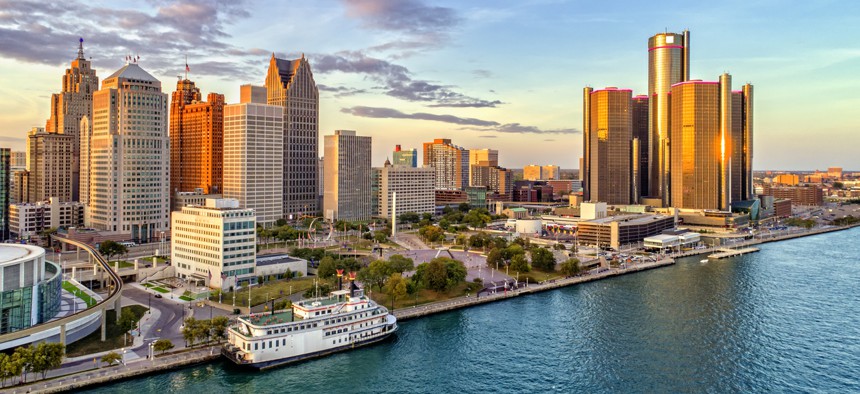The Mayor’s Guide to Spending Federal Aid

Detroit skyline. istock.com/pawel.gaul
COMMENTARY | Cities should use the rescue funds to make big and bold changes that will propel them into the future.
Powered by the American Rescue Plan and possibly the American Jobs Plan, cities are set to receive colossal federal dollars, totaling nearly $3 trillion. This unprecedented federal investment into our cities is unlike anything we’ve seen or are likely to see again in our lifetimes. Mayors must seize this moment as an opportunity to reset, reimagine and revitalize our cities.
As a former deputy mayor of Minneapolis and an architect of Detroit’s “Grand Bargain”—an $800 million public-private plan to help Detroit exit from the nation’s largest municipal bankruptcy—I know the temptation for mayors is to focus on the short term and not create big, bold, new programs for which they will have to find funding after the federal money is spent. Additionally, many cities were hit hard financially so plugging the budget holes caused by Covid-19 first makes practical sense.
However, the best part of this federal funding is that it allows cities to deal with the financial consequences of the pandemic while allowing them to think more expansively and use the money as a bridge to a more transformational suite of investments that will reshape the physical, economic and social fabric of cities for generations to come.
There are multiple roadmaps for how to do this right, but I can’t think of one more compelling than plain laid out in my hometown of Detroit, which received $826 million of American Rescue Plan (ARP) dollars—the nation’s fourth largest allocation.
Mayor Mike Duggan has created a robust, community-informed plan to spend the dollars wisely. Detroit’s allocation of ARP dollars puts down critical markers: building financial assets in communities of color through housing and small business ownership; ensuring equitable access to key drivers of a high-quality of life through parks, open space, recreation centers, arts and culture; and strengthening the ability of community residents to participate in city decision-making through the municipal budget process and investments in neighborhood organizations.
These are vital down payments, setting the stage for deeper, more sustained investments that will fundamentally alter the machinery of social change in our city.
As the waterfall of next-generation federal monies begins to take shape more sharply, I believe cities could direct federal dollars into eight transformative, once-in-a-generation set of investments:
- Creating comprehensive regional transit systems.
- Creating a continuum of educational experiences from early childhood development to K-12 education to higher education.
- Redesigning a system of community-based finance institutions that enables more capital to flow to small businesses owned by people of color.
- Engineering next-generation climate-resilient infrastructure for stormwater management, heat island mitigation and flooding prevention.
- Advancing family wealth-building strategies such as community ownership of real estate, “baby bonds” and guaranteed income supports;
- Fortifying the provision of high-quality early childhood programs through facilities improvements, increased wages for child-care providers and improved quality certification standards.
- Investing in forums and channels that fortify the ability of community residents to participate meaningfully over the long term in making decisions that affect their daily lives.
- Reforming municipal public health systems to become more focused on the upstream social determinants of health outcomes, integrate institutional care with community care, and build pipelines of diverse and inclusive health care professionals.
We need mayors and city leaders across the country to adapt this transformative thinking to their circumstance, their capacities, and—most importantly—to their vision for the future of their communities.
Rip Rapson is president and CEO of The Kresge Foundation, which is dedicated to expanding opportunities in America’s cities through grantmaking and social investing. He is a former deputy mayor of Minneapolis.
NEXT STORY: Cities worldwide aren’t adapting to climate change quickly enough





